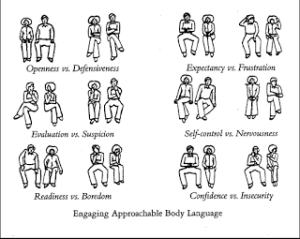How to Use Body Language to Your Advantage at Work
Body language is an integral part of how we communicate with one another. It always has been and it always will be. Some of us talk with our hands, most of us shift in our seat when we start to get nervous, and all of us do it without thinking.
Unfortunately, we live in a world where societal expectations, and adherence to them, are of greater consequence in some areas of our lives than they are in others. This is particularly true with respect to the workplace. Because success in the corporate world is dependent upon our ability to communicate the right things in the right way, there is much higher emphasis on the agreement of our body language with the message that we are trying to convey.
Careless mistakes that result in mixed messages could spell out millions of dollars in loss, and a subsequent pink slip for even the most promising salesman.
However, body language is, for all practical purposes, a wild card. This means that for all the damage it can cause, it can also be used strategically to help you reach your career goals, and to give you a competitive edge over colleagues who want a promotion as badly as you do.

Here are some ways in which you can use body language to your advantage at work.
Eye Contact
Maintaining eye contact with your clients is the single most effective way to let them know that you value what they have to say. It’s also one of the most difficult techniques to matter. It may take some time for a client to say what they need to say. Unfortunately, most of us are visual learners, and in order to process what is being said, we need to visualize something that isn’t there. When this happens, our temporal vision becomes non-existent. The result is a glossy, dazed look that may indicate to your clients that you are in your own little world. Stay in theirs by discarding minute details and abbreviating whole ideas into something easily retrievable.
Crossing your arms in the presence of a client will tell them one of two things…you’re either bored or on the defensive. In any case, as far as your client will be concerned, you have no desire to hear what they How to Use have to say. Instead of giving your client a reason to shut down, keep your arms open and let them voice their concerns. The direction of sale can turn at any moment, and a lack of communication will make it much more difficult for you to pick up on it.
Lean Forward
Leaning in towards your client lets them know that you are listening. Leaning forward is a way of letting your client know that you are engaged in the conversation, and that their needs are your first priority. Leaning forward denotes empathy, and your commitment to your client’s satisfaction. The moment you indicate to your client that their autonomy is more important than your monthly quota, your chances of closing the sale go from zero to 90%.
Smile
Many people overlook the importance of smiling when their relationship with a client has moved from phone calls to dinner meetings. Dollar signs have a tendency to bring out the worst in people, especially if they know they’re about to watch them disappear. Smile with your eyes to cut some of the tension. This simple gesture indicates to your client that you are more than just the corporation you represent, and invites them to approach you with their concerns about sensitive subjects, like price.






